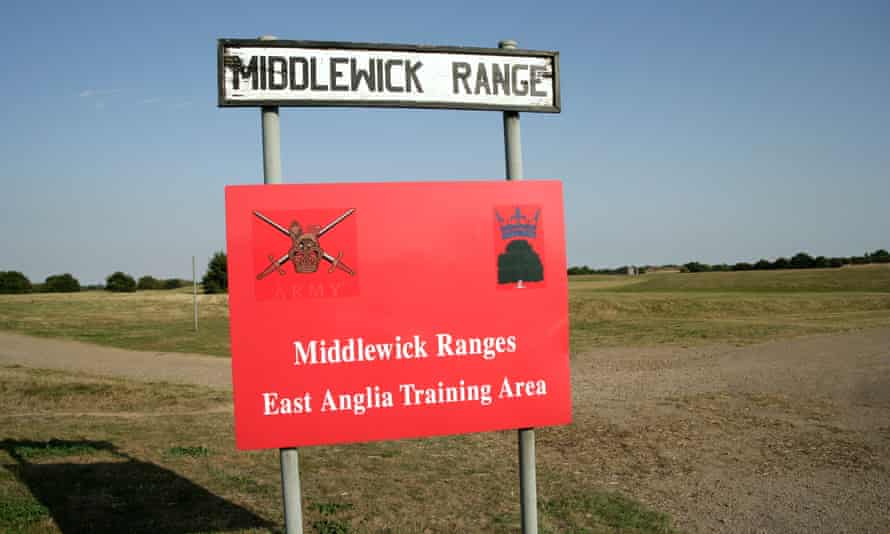Ministry of Defence under fire for ‘inventing rules’ to sell wildlife haven
Campaigners say MoD and local authority agreed ‘bespoke metric’ to push through permission to develop Middlewick Ranges in Essex

The Middlewick Ranges are an ecological marvel by the standards of 21st-century Britain. The army firing range near Colchester, Essex, has been untouched by a plough for nearly 200 years, allowing skylarks and nightingales to feast on the threatened invertebrates and insects that thrive in the rare acid grassland.
Yet a plan to sell off the ranges to build more than 1,000 homes has prompted accusations from campaigners that the Ministry of Defence (MoD) has rewritten environmental protection rules to suit its case.
Acid grassland – named after the acidic soil that supports fine grasses and lichens – has almost disappeared from England, and is protected under guidelines from the Department for Environment, Food and Rural Affairs (Defra). Planning rules allow developers to build on some types of rare land, including fens, wetland and woodland, so long as they offset the loss by creating replacements. Defra’s Biodiversity Metric allows them to calculate how to do that.
“Under the Defra metric, it says that the score is too high to allow development,” said Richard Martin, from the Save the Middlewick Ranges group. “They couldn’t use it, so they came up with their own one. It’s crazy.”

The MoD’s property arm, the Defence Infrastructure Organisation, agreed the use of a “bespoke metric” with Colchester borough council to push through outline permission to develop the 86 hectare (215-acre) site under the plan. Even worse, according to the campaigners, is how the MoD proposes to replace the acid grassland, by converting farmland nearby.
“They want to put sulphur into the land,” Martin said. “There’s a little brook that runs next to it and all the lands drain into that brook.
“And that flows into Colne Marshes, which is a site of special scientific interest. So you’re going to put sulphur in the rainwater that flows into a SSSI wildlife site.”
The campaigners have been supported by Essex Wildlife Trust, which calls Middlewick Ranges “a major ecological asset” with “precious habitats essential to nature’s recovery”, adding: “We cannot afford to lose them.”
The campaigns resulted in a planning inquiry into how the ranges were added to the local plan, which concluded its hearings earlier this year.
Rosie Pearson, a founder of the Community Planning Alliance, which has advised the campaigners, said: “From a biodiversity perspective, this should be ringing a jumbo alarm bell. The developers couldn’t do what they wanted using the official metric, so they made one up. For the rare species inhabiting the site this could be the death knell – unless the planning inspectorate recognises that what is being attempted is deeply flawed.”
Pearson said developers have been manipulating biodiversity offsetting, adding: “Skylarks are offered ‘offsite plots’ when their meadows are concreted over. Large swathes of ancient woodland have been described as ‘copses’. And arable land is largely dismissed as meaningless for wildlife in the metric.” She said ecological assessments should be done by an independent body, funded by developers, adding: “Local communities should be able to request a second opinion, also funded by the developer, if they have concerns about a report. And government proposals to provide better funding to local authorities for ecology services should be followed through.”
The MoD has defended its plans, saying 63% of the land would be reserved for green open space. It has yet to sell the site to a developer, who would still need planning permission, but if the plan is upheld, opposition would be limited to discussing which parts of the ranges could be built on.

There are more than 460 environmental campaigns across Great Britain according to the Community Planning Alliance, which is concerned that new planning rules – blamed by Tory activists for the Lib Dem victory in the Chesham and Amersham by-election last month – will make it harder for local groups to stop similar developments.
The MoD’s plans rely on a similar project to create acid grassland at the RSPB’s Minsmere reserve in Suffolk.
Adam Rowlands, the RSPB’s Suffolk area manager, who is not involved in Middlewick Ranges dispute, said that creating the acid grassland at Minsmere had taken about 10 years. “It was not an easy task,” he said. “There was quite an intensive period of establishment, scarifying the soils, sowing seed mixes. You can’t just rewild it, otherwise it will turn into scrubland.”
A spokesperson for Colchester borough council said: “Middlewick Ranges is allocated in the Emerging Local Plan for mixed use including housing, open space and community uses.
“The future of the ranges has yet to be finalised, as we continue to await the Local Plan Inspector’s report, but it will be important to ensure residents have an opportunity to comment if the site is included in the Plan.
“Future master planning of the site will need to be undertaken, which will include open space and increased tree-planting, to enhance the biodiversity value of the ranges for future generations of residents to enjoy.
“Whilst we are unable to comment on DIO’s specific plans for the sitethe council remains fully committed to preserving and enhancing all forms of biodiversity in the borough to the greatest extent possible.”
The MoD said: “We continue to work with the council to develop plans for the site, including working with experts to find innovative means to help secure biodiversity. The techniques will be thoroughly tested as part of the examination process.”